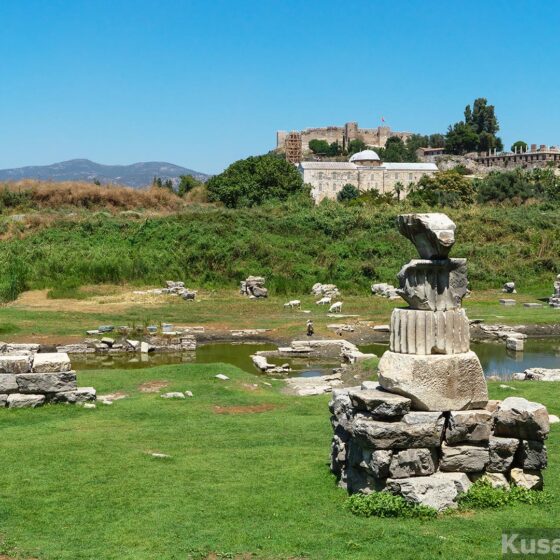Table of Contents Show
As you step onto the cobbled stones of ancient Ephesus, your gaze will inevitably be drawn towards a grand structure standing tall against the backdrop of centuries-old ruins. This is the Library of Celsus – a testament to the cultural richness of Ephesus and a monument built to honour the Roman Senator, Tiberius Julius Celsus Polemaeanus.
A Glimpse into the Past
Constructed between 114-117 AD, the Library of Celsus once held over 12,000 scrolls, making it one of the most significant libraries of the ancient world. Its two-story facade, adorned with intricate statues and Corinthian-style columns, radiates an aura of grandeur that captivates every visitor. Each of the statues symbolizes Wisdom (Sophia), Knowledge (Episteme), Intelligence (Ennoia), and Virtue (Arete) – all qualities Celsus embodied during his life.
The Restoration and Beyond
Although the library was destroyed in an earthquake in 262 AD, it was meticulously restored by archaeologists in the 1970s. Today, you can admire the impressively reconstructed facade, a sight that will transport you back in time to Ephesus’ golden age.

The Library in Modern Times
The Library of Celsus has transcended its physical structure to become a symbol of the enduring allure of Ephesus. It continues to draw scholars, history buffs, and travellers from across the globe, eager to glimpse the cultural richness of this ancient city.
One lesser-known, yet captivating, aspect of the Library is its unique architectural design which is intended to maximize the preservation of the scrolls. The creators of the Library had incorporated an effective system to protect the valuable papyrus scrolls from the damaging effects of moisture. The walls were constructed to be double-layered with an inch gap between them. This design kept the inside of the building dry and cool, preserving the precious scrolls from the humid climate of Ephesus.

Additionally, it’s interesting to note that Celsus himself is entombed in a lead container beneath the library in a marble tomb. This is quite unusual as it was a practice in the Roman period to bury the dead outside the city limits. Celsus’s burial within the city signifies a special honour bestowed upon him.
Finally, it’s worth mentioning that the Library of Celsus was not just a library in the conventional sense. It was also a monumental tomb, a practice not uncommon in antiquity where knowledge and the afterlife were closely intertwined. It’s a reminder that libraries were considered sacred spaces, repositories of wisdom, and gateways to the divine.
See also:
- Library of Celsus on Google Maps
- Ephesus After Dark: A Nighttime Exploration of the Ancient City
- 5 Fascinating Facts About Ephesus in Turkey
- Unveiling the Treasures of Ephesus: A Must-Visit Ancient City
Are you planning a visit to Ephesus and intrigued by its historical treasures? We at KusadasiTurkey.com can help you plan your trip, including arranging a private tour of Ephesus that includes the Library of Celsus and other significant sites. Contact us today for a bespoke travel experience tailored to your interests and preferences.
Last updated on February 11, 2024




